A Sand Dollar's Breakfast Is Totally Metal
Pristine white sand dollars have long been the souvenir to commemorate a successful day at the beach. But most people who pick them up don’t realize that they’ve collected the skeleton of an animal, washed up at the end of a long life.
As it turns out, scientists say there’s a lot to be said about a sand dollar’s life. That skeleton — also known as a test — is really a tool, a remarkable feat of engineering that allows sand dollars to thrive on the shifting bottom of the sandy seafloor, an environment that most other sea creatures find inhospitable.
“They’ve done something really amazing and different,” said Rich Mooi, a researcher with the California Academy of Sciences in San Francisco. “They’re a pile of novelties, and they’ve gone way off the deep end in modifying their bodies to adapt to where they live.”
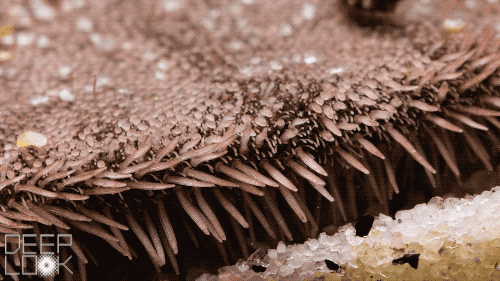
Mooi studies echinoderms, a word that roughly translates to “hedgehog skin.” It’s an aptly fitting name for a group that includes sea urchins, sand dollars, sea stars and sea cucumbers. But Mooi said sand dollars really have his heart, in part because of their incredible adaptations.
Sand dollars are actually a type of sea urchin, one that struck off on its own in an evolutionary pilgrimage to take advantage of a new environment.
This connection is more obvious when looking at a common feature of the group: symmetry in multiples of five. Starfish have five arms, for example, while the test of a sea urchin is divided into 10 plates: five with tube feet and five with spines. Similarly, a sand dollar has five “petals” that house its specialized breathing tube feet.
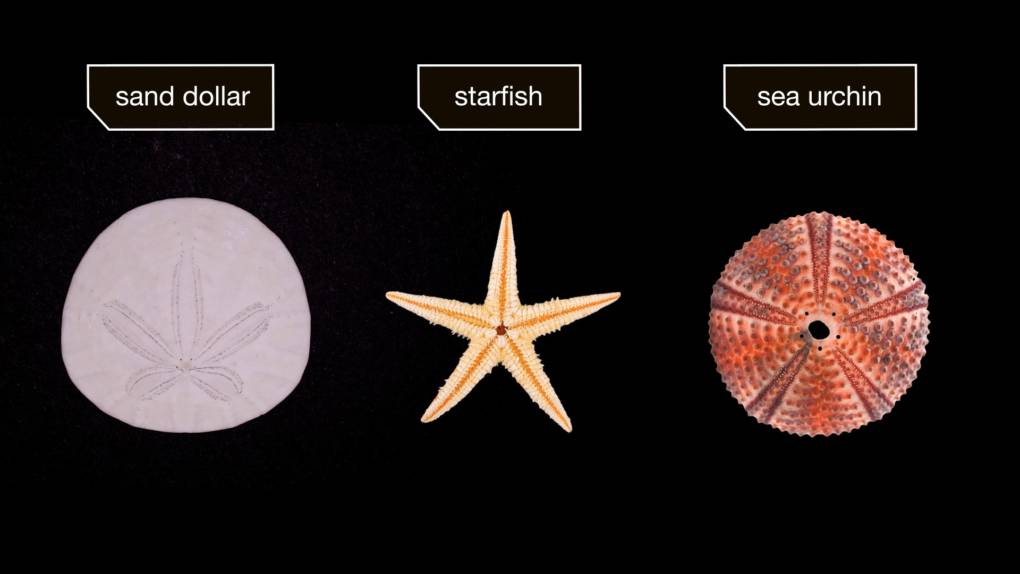
Most sand dollars are solitary and small (up to 3 inches) and can be found along the world’s shorelines to as deep as 130 feet. Researchers are unsure how long they live, with typical estimates ranging from six to 10 years. But recent work on their sea urchin cousins, which traditionally were thought to have a similar life span, suggests they may be among the world’s oldest animals.
Shuffling slowly across the bottom on stiltlike spines, they pick up sand to pass along special feeding grooves, bucket-brigade style, to a mouth on the underside of the disk. The sand dollar’s mouth has a jaw with five teethlike sections, which are the origin of the “doves” in the familiar postcard poem “The Legend of the Sand Dollar.” They use these teeth to grind up sand, but it’s really the coating of microscopic algae and bacteria on each grain that they’re after.
“Sand dollars are dealing with microscopic things, individual sand grains,” Mooi said. “So their whole body system is adapted to being able to handle small particles.”
When you picture a sea urchin, you might think of their long, pointy spines and their strong, suctioning tube feet. These are great tools for wedging into crevices and gripping rocks to avoid sudden waves.

But on sand, where the very ground is in constant motion, the strategy is to minimize.
If you pick up any sand dollar and observe it edge-on, it looks like an airplane wing alive with a flurry of activity: tiny spines, tube feet and miniature pincers called pedicellariae that carry out various tasks.
Or perhaps, said Mooi, a bicycle.
“If you imagine yourself riding into the wind on a bicycle, you find yourself hunching over to get down out of the wind,” he said. “You’re trying to minimize drag. That’s what sand dollars have done.”
And similar to a spoiler on a car, many species have specialized holes in their skeletons known as lunules, which help equalize pressure as water flows over them to greatly reduce lift.
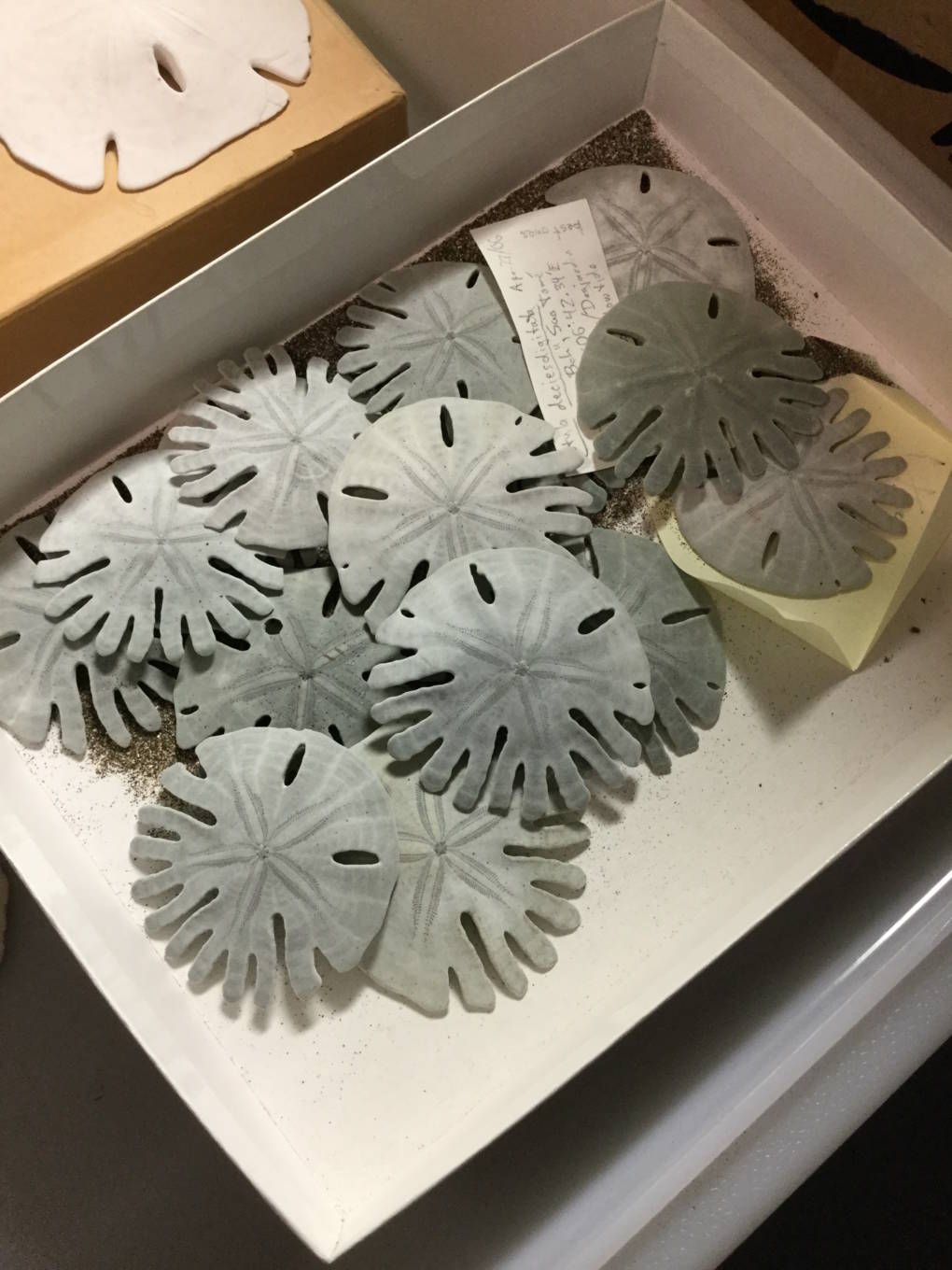
“It’s the same reason that bombers during World War II couldn’t fly as well when they had holes punched through the wings,” he said.
One species on the West Coast of California has taken its body modifications a step beyond. Mooi described the eccentric sand dollar (Dendraster excentricus) as “a weirdo on the West Coast. We like to do things differently here, and sand dollars are no exception.”
While sand dollars are usually solitary, these dollars group together in dense purple fields of up to 625 individuals per square yard. Larvae in the water use chemical cues from adults to indicate that they’re in a good place to settle out of the plankton and grow.
As they grow, they develop off-center, with the gills, feeding grooves, reproductive structures, mouth and anus offset to one side of the body. This pattern of development is known as eccentricity, and this is how they get their name.
When they are large enough to begin feeding, eccentric sand dollars align themselves parallel to the current and tip up on their edges, anchoring one end in the sand while the other sticks into the streaming waters above.
To put it bluntly, “they’ve got their little butts in the air,” Mooi said with a chuckle. “It’s quite brilliant.”
The reason: They’re filtering feeders. While most sand dollars move along the bottom, grinding up sand to eat the rich microbial organisms adhered onto them, eccentric sand dollars pluck tasty plankton morsels straight from the current by turning on-end. They’re the only sand dollar species known to feed in this way.
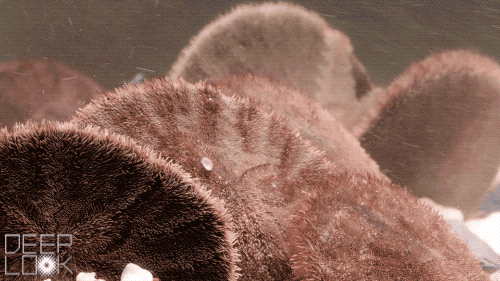
“They’re very hydrodynamically attuned animals,” Mooi said, “and they have this ability to exploit current flows.”
Another compelling trick: While older sand dollars are heavy enough to keep themselves firmly on the bottom, younger dollars have crafted something that may be familiar to any scuba diver or spear fisherman. They use a weight belt.
Sand is made up of small bits of rock and debris. The rocks along the coast determine which minerals will be present in the sand. Magnetite is one such mineral, an iron-rich deposit named for its magnetic properties. In sand, it is often seen as very small, slightly shiny black specks.
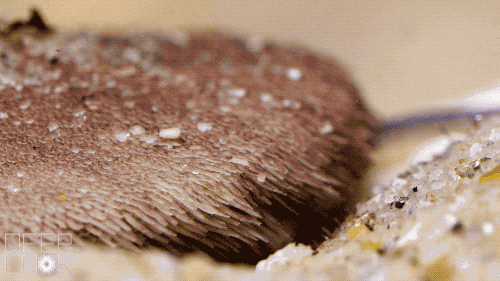
Young sand dollars can pick small grains of magnetite from the surrounding sand and store them in specialized chambers of their gut called diverticula. When X-rayed, the magnetite appears as bright patches. They help weigh down the younger dollars, keeping them grounded until they bulk up as adults so they don’t wash away.

According to Chris Mah, a researcher with the Smithsonian Institution’s National Museum of Natural History in Washington, D.C., these kinds of behaviors are an elegant example of how evolution can drive species to perfectly adapt to any habitat.
“With sand dollars, there’s so much of the story of their adaptation to sandy environments that makes sense,” he said, “and it’s hard not to appreciate how lovely they are when they’re arranged in such an ordered, but aesthetically wondrous, pattern.”